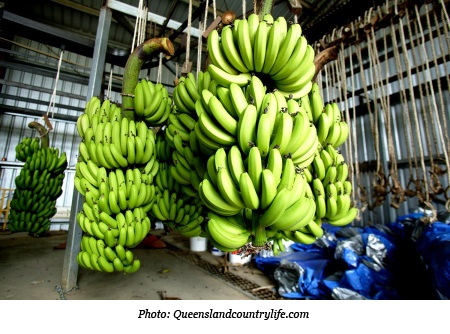by Ashley Walmsley, Queensland Country Life
Long-term implications from the detection of Panama disease Tropical Race 4 (TR4) could re-open the discussion on banana imports.
 But the Federal Department of Agriculture is confident the presence of Panama disease in Australia would not have implications for fresh banana imports from other countries.
But the Federal Department of Agriculture is confident the presence of Panama disease in Australia would not have implications for fresh banana imports from other countries.
From 2000 to 2008, the banana industry fought to prevent the importation of Philippine bananas citing disease risks as the key concerns for not allowing the fruit in.
In 2008 the federal government released the Final Import Risk Analysis (IRA) Report for the Importation of Cavendish Bananas from the Philippines which gave the green light to Filipino banana imports under strict quarantine conditions.
“The Philippines will be required to demonstrate that the risk management measures can be achieved under commercial conditions on an ongoing basis,” a Department fact sheet stated.
A departmental spokesperson told Fairfax Media the department takes a stringent approach to biosecurity.
“That is why we take a careful look at any requests to import products into Australia. Any recommendations we make are based on science,” the spokesperson said.
It confirmed that there had been no recent requests to import fresh bananas from any overseas market.
“Panama disease was assessed in the Philippine banana IRA but the pathogen was considered not to be associated with fresh commercial fruit,” the departmental spokesperson said.
“The Philippines have not sought to export bananas to Australia.”
The Queensland Department of Agriculture told Fairfax Media it was involved in handling the current disease outbreak and wasn’t commenting on speculative future impacts.
Despite outcries from the banana industry, including protest marches in Cairns, the Department declared the final IRA report a “comprehensive, science-based analysis that reflects Australia’s appropriate level of protection”.
While not making significant mention of Panama disease, the final IRA report identified seven groups of pests and diseases of concern, notably Moko, black Sigatoka and freckle, as well as a number of other pests not present in Western Australia that are present in eastern Australia.
In 2001, Australia spent $20 million eradicating the leaf disease black sigatoka from North Queensland plantations at Tully.
The source of that disease incursion remains unknown but it caused plantations to be ploughed out during a two-year eradication program involving an intensive de-leafing and spraying schedule before the industry eventually regained its official pest-free status in 2005.
Source: Queensland Country Life
